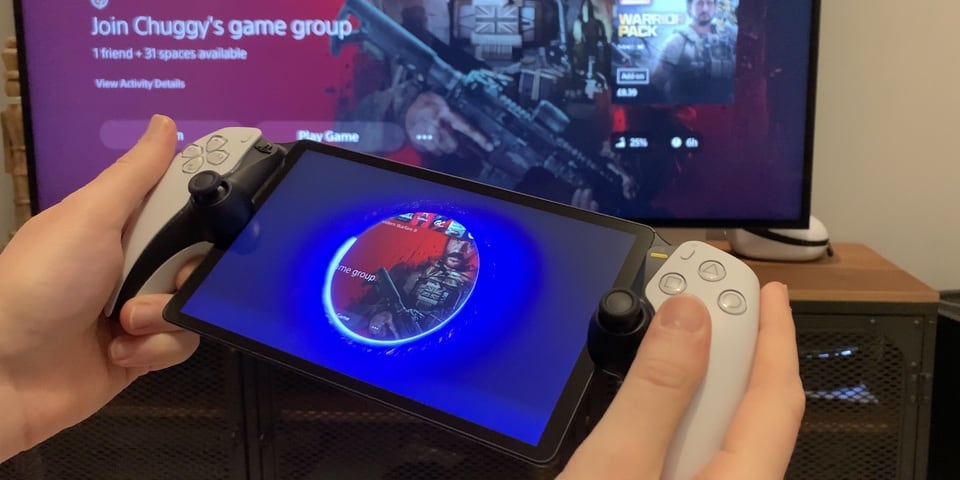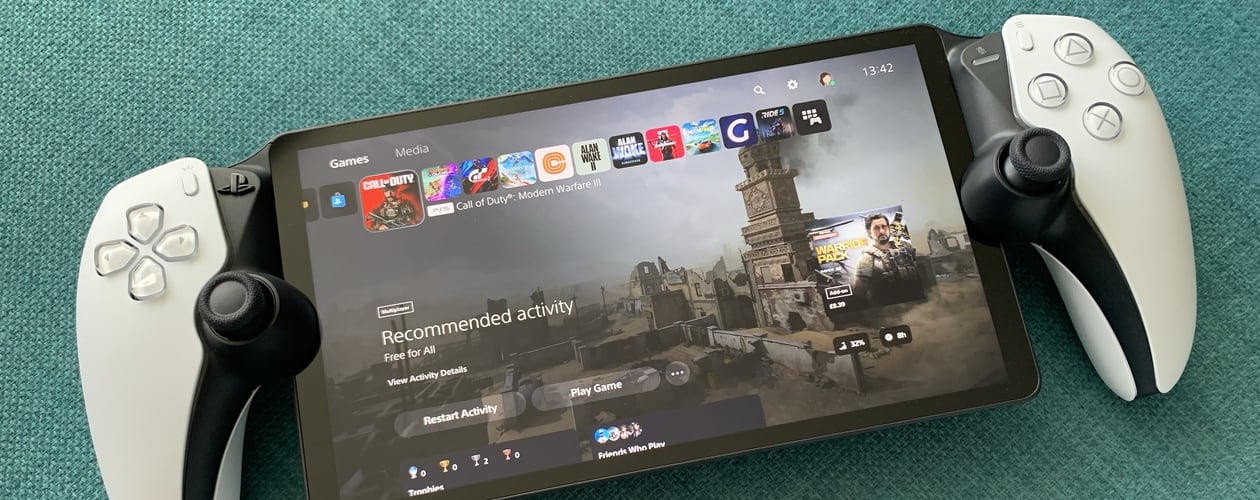The PSP and PS Vita were both truly special consoles. Delivering leading handheld gaming performance in what would now be startlingly compact handheld forms, they became home to both impressive high end games and burgeoning indie gaming scenes… but one of their best tricks was remote play, able to connect to PS3 or PS4 to genuinely play those full fat home console games. Someone somewhere wished on a cursed monkeys paw for a new PlayStation handheld, and as the finger creakily folded into the palm, the PlayStation Portal went into production.
PlayStation Portal is, in essence, a single purpose device – while it looks like it could be so much more, it’s a pure remote play handheld for PS5. From a design perspective, it’s a DualSense controller that’s been split in half with an LCD screen and Android welded into the gap, and loaded with just enough processing hardware to let it connect to and stream games directly from your console.
And of course, Sony has nailed that design. Picking the Portal out of its box, there’s just as much heft, solidity and rigidity as you’d expect, with the one real surprise being how the screen is recessed from the face buttons and analogue sticks, and angled downward. It’s a striking stylistic touch, adding a little flair to a rather straightforward idea. Flip it around, though, and it looks a little funny, like they got Salvador Dali in to do a bit of plastic stretching, leading to a white connective band hiding the bulge for the battery and other innards.
Along the top you’ll find the power button, volume buttons and a dedicated button for PlayStation Link audio connections, and with the USB-C port for charging and a 3.5mm headphone jack tucked behind the lower edge of the white band. The pad features all of the DualSense goodies, with adaptive triggers, haptic rumble, and that familiar grip style. The only real tweak in this regard is that the thumb sticks are slightly miniaturised. Oh, and there’s no touch pad… because there’s the whole screen for you to tap and swipe at instead, and two large areas intended for this on the screen.
- PS Portal vs. DualSense
- PS Portal rear USB-C and 3.5mm jack
- PS Portal top buttons
- PS Portal vs. Nintendo Switch
The 8″ screen in the PS Portal is big, bright and thoroughly saturated with colour, trying to dial up that visual wow factor as much as possible without featuring an OLED screen. While Nintendo Switch and Steam Deck compromise with a 720p screen, PS Portal pushes the boat out for a rather nice 1080p LCD panel that brings both really fine detail and very poppy colour.
So what’s it like to use? Once you’ve gone through the simple set up process – connect to Wi-Fi, let it do some updates, log in to your PlayStation Account and the set up the remote play connection to your PS5 – you’ll be greeted by a strange orb when you boot up the controller, waiting for you to tap a button to turn on and connect to your console. Wait a few moments and it will resolve to the PS5 UI and then swirl off the screen like you’re emerging through one of Doctor Strange’s portals.

Your first impressions of this handheld will be defined almost entirely by your home Wi-Fi network. Where PS Vita could optionally connect directly to a PS4 for a lower latency connection, PS Portal will only go through your home network or over the internet.
Simply put, there is a world of difference between playing with my PS5 on Wi-Fi or on Ethernet. On Wi-Fi, the resolution suffered, playing COD Modern Warfare 3 was a struggle to aim through slowdown and stutters, and it was just a disappointing experience in general. This won’t have been helped by the Portal only having a 1×1 Wi-Fi antenna, making it a little more prone to weaker Wi-Fi signals than a 2×2 MIMO config, but once I switched the PS5 back to Ethernet, things cleared up significantly, the stream to the portal became pretty close to a pristine 1080p at 60fps. My MW3 game improved… slightly.
Something that I find rather impressive was the low latency that was possible here. My TV is a 2016 vintage Sony XD9305 and doesn’t come with the lowest of latencies for gaming. The PS Portal was effectively a match for this standard TV experience with just 2 added frames at 60fps that I could record – an additional 33ms. Obviously, if you’re gaming with an ultra-low latency mode TV or screen, the remote play latency could be more noticeable, but for me, this was pretty darned good.
We’ve only used the PS Portal within the home but it’s theoretically possible to take it on the go and connect back to your PS5 via the internet – theoretically, because you don’t get a carrying case, and Portal’s shape does feel like it could get mangled in a bag. You will, of course, be entirely at the mercy of whatever hotel Wi-Fi, your phone’s hotspot, and your home broadband’s upload speed for the quality of experience that you get from this.

There are, unfortunately, some rough edges that Sony will hopefully be able to address through software updates. For one thing, I find that the lowest volume setting is still way too loud – certainly much, much louder than my iPad Mini – which would absolutely force me to use headphones if gaming with others in the room. Speaking of which, it’s cabled headphones or PlayStation Link only, so if you were hoping to use Bluetooth headphones like you can with literally any Android tablet in existence, you can apparently go and do one. Then again, the PS5 itself doesn’t allow standard Bluetooth headphones either, so this isn’t really anything new from Sony.
Then there’s the rumble. I believe that there’s the exact same haptic motors in the Portal as in the DualSense, but the end result here is often a lot more rough and harsh, like the old rumble motors in a DualShock 4. You can still get the single tips and taps of footsteps in Ratchet & Clank Rift Apart, but when in Modern Warfare 3 or Gran Turismo 7, a lot of subtlety and nuance is lost. It’s strange. You can hop into the controller’s own system settings, where you have options for vibration and trigger effect intensity, but it’s a strange disconnect from the defaults on PS5.
You also have to accept that you’re playing with video output that’s encoded on the fly, and all the compromises that brings with it. Where a raw bandwidth of HDMI allows flawless colour depth and chroma, this data gets crushed when streamed, so colour banding becomes rather noticeable whenever the game or even main menus feature a subtle gradient.

But the biggest failure by far is that the PlayStation Portal doesn’t have support for Sony’s PlayStation Plus cloud gaming platform, and there are no publicly announced plans to add this feature in future. It’s just utterly baffling and bizarre to limit the Portal in this way at the exact same moment that Sony has sought to boost and expand its cloud gaming credentials, and there’s certainly no technical reason why it couldn’t.
And that leaves PlayStation Portal feeling a little bit like those one trick pony peripherals of the 90s and early 2000s. In fairness, it is far more versatile than a Donkey Konga set or Dreamcast fishing rod, and I’ve certainly had a perfectly reasonable gaming experience on it, but it’s a niche within a niche.
Priced at £200, the PlayStation Portal is at least significantly cheaper than the Logitech G Cloud ($350) or Razer Edge ($400) cloud gaming handhelds. Those both feature remote play to Xbox Series consoles, they both support Xbox Game Pass cloud gaming (and other platforms on Razer), and they can also play Android tablet games, because that’s fundamentally what all these devices are. Of course, another alternative is to use the remote play app on a phone or tablet and a DualSense or some kind of controller grip, such as the PlayStation licensed Backbone.
The PlayStation Portal sets out to do one thing and does it well, letting you play your PS5 separately from whatever screens it’s connected to, and bringing the DualSense haptics, triggers and design along for the ride. The thing is that this could and really should do more, not just hooking up not just to your PS5, but to the PS Plus cloud as well.








